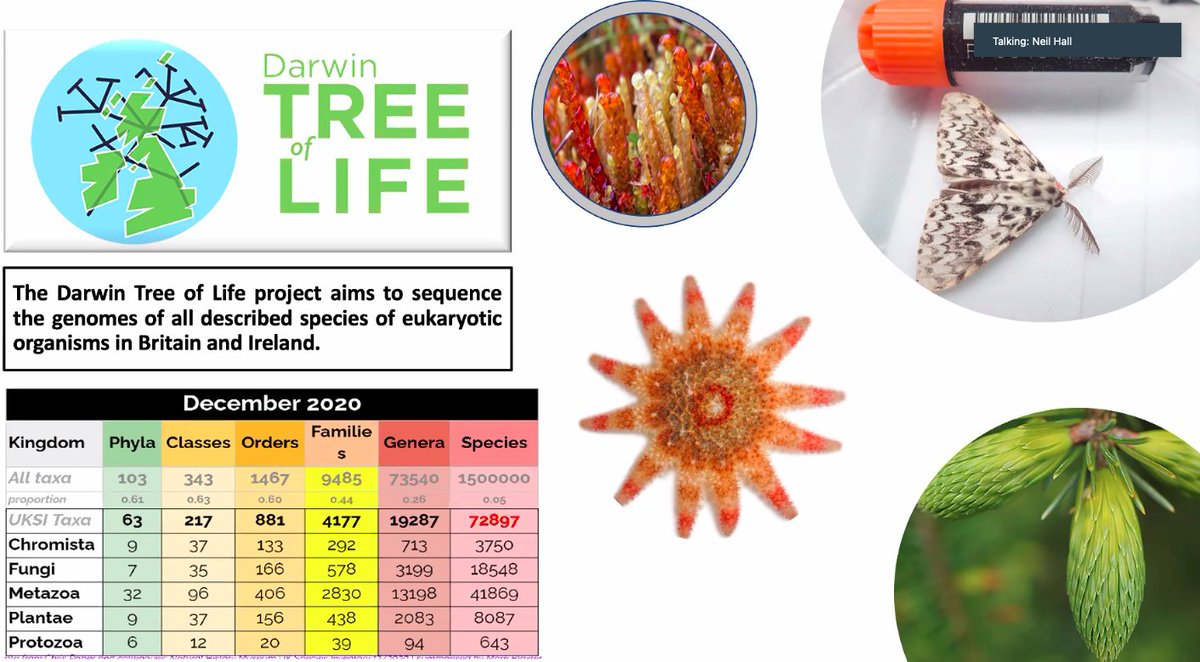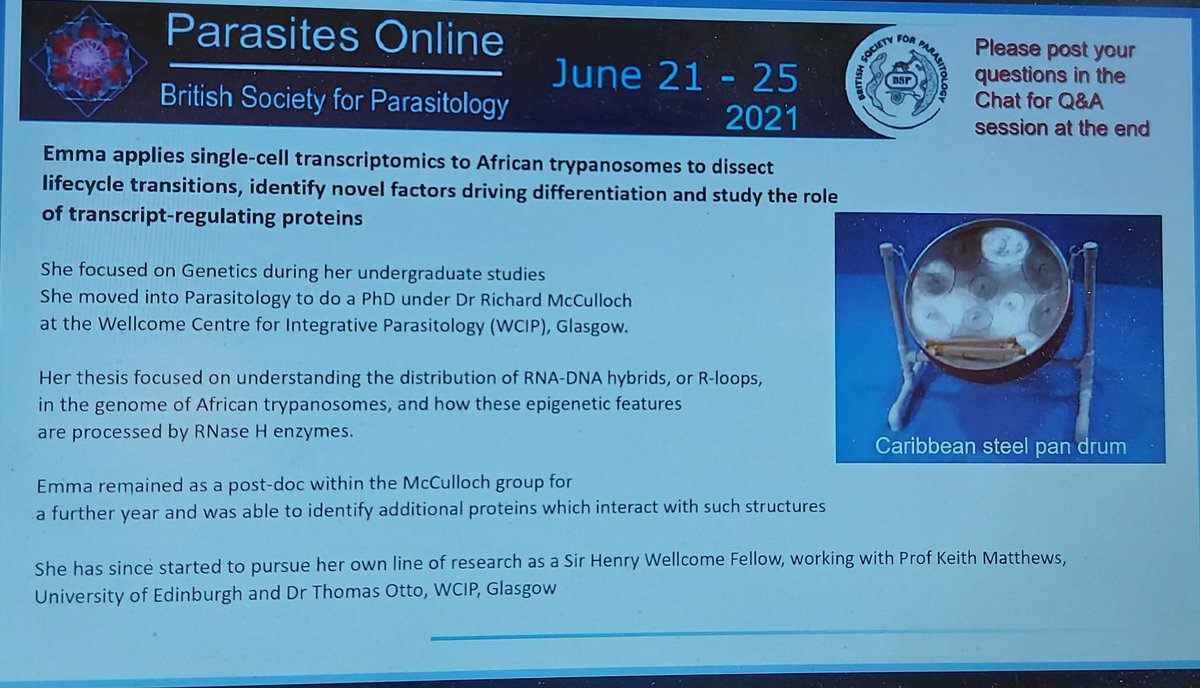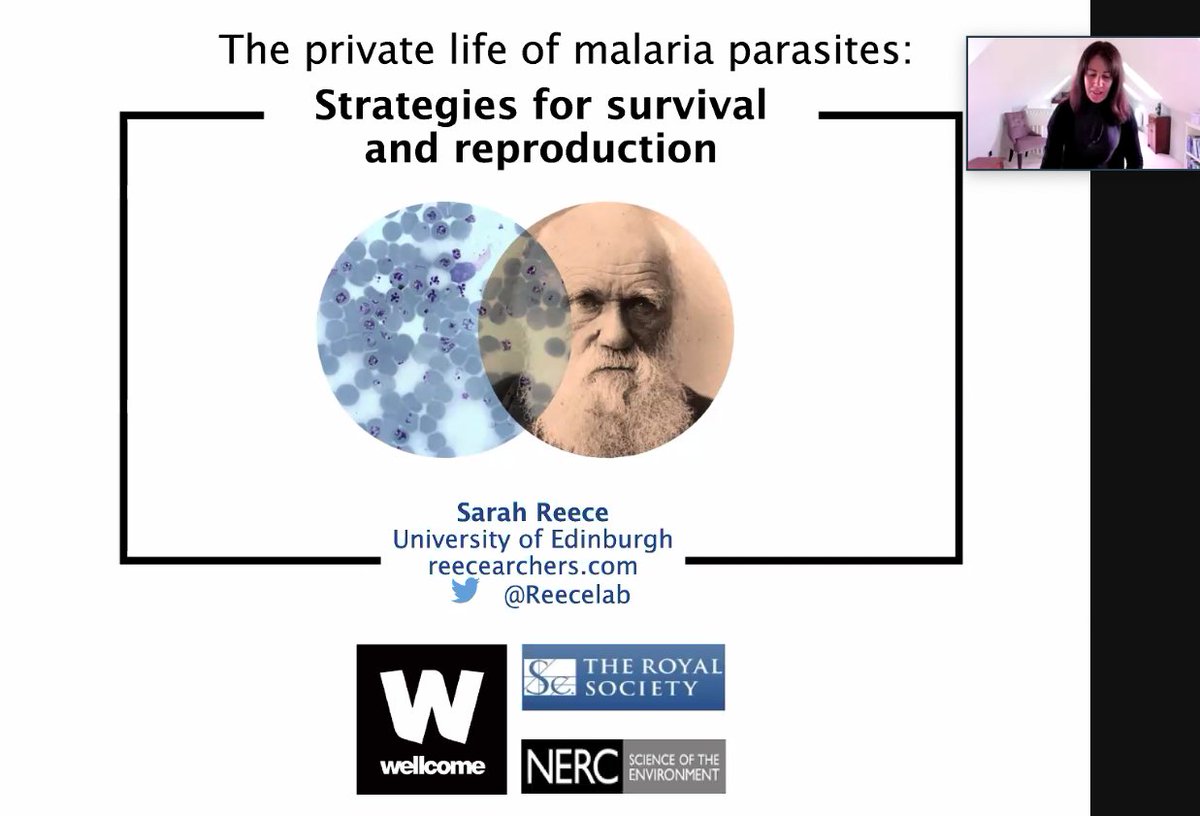
Day 4 of our #ParasitesOnline21 meeting will begin with a presentation by Dr Emma Briggs who was awarded the BSP President's Medal in 2020 🏅 @emmabriggs6
https://twitter.com/BSPparasitology/status/1255061272569274368
So to begin our "BES: Ecology and Evolution I" Session of Day 4 of #ParasitesOnline21 is Prof Neil Hall of the @EarlhamInst with "Sequencing #Protists directly from the environment for the Darwin Tree of Life Project." 

Prof Neil Hall describes how G+T seq is used to identify the phylogenetic diversity of samples and what eukaryotes are present in environmental samples, citing nature.com/articles/nmeth… and nature.com/articles/nprot… #ParasitesOnline21
All of the Darwin Tree of Life data is made freely available and published, and you can follow along at @darwintreelife and at the website at darwintreeoflife.org! Great resources & you can suggest a species to sequence if it hasn't already been done! #ParasitesOnline21
Now we follow the @darwintreelife talk with two #Plasmodium lectures, the 1st from @pschneiderEDIN of the @ReeceLab, with "Who’s to blame? Host-vector-parasite interactions in timing transmission." #ParasitesOnline21 

Dr Schneider tells us about "Hawking's hypothesis": that schizonts burst at the specific time of day to coincide with maturation of the transmissible forms (gametocytes). The 1970 paper suggesting this is at jstor.org/stable/24925831 #ParasitesOnline21
Dr Schneider of the @ReeceLab uses #Plasmodium chabaudi to examine whether parasite or host rhythms drive daily patterns in gametocyte infectivity. You can read some of her findings at royalsocietypublishing.org/doi/10.1098/rs…, but more to come also! #ParasitesOnline21
Future work will include the determination of host factors that mediate transmissibility, for example, by examining host serum from different times of the day! Follow @ReeceLab and @pschneiderEDIN to keep up with their research! #ParasitesOnline21
And now we have talk 3 of the #ParasitesOnline21 "BES: Ecology and Evolution I" session: Dr Lindsey Plenderleith of @uniofedinburgh who will tell us about "A new Plasmodium species in African apes reveals the origin of human #Plasmodium malariae." #malaria 

Very interesting to see nucleotide divergence of 13.5% between #Plasmodium malariae (M1) and a malariae-like Plasmodium species (M2); such difference that it appears to be a distinct species. Dr Plenderleith cites this recent malariae paper for background: nature.com/articles/s4159…
And there is a great review on the ape origins of human #malaria featuring Dr Plenderleith at ncbi.nlm.nih.gov/pmc/articles/P… But look out for more of this malariae work in future! #ParasitesOnline21
And now for our final "BES: Ecology and Evolution I" talk today: Bethan Mason of Masaryk University in the Czech Republic with "Diversity of Strongylid #Nematode Communities in Wild Western Lowland Gorillas." #ParasitesOnline21 

This work featuring Bethan Mason is all new, but if you are itching to read more of the results right now, make sure to look up the PhD thesis of Dr Vladislav Ilík which is available from Masaryk University (is.muni.cz/th/vg2vb/DP_Il…). Beautifully written thesis from this group!
Now we begin our second "BES: Ecology and Evolution" session of #ParasitesOnline21 with Prof Bernd Sures of the Universität Duisburg-Essen with "Environmental #Parasitology: relevance of parasites in ecotoxicological studies." 

Prof Sures is telling us about metal uptake by #parasites and how parasites interact with pollutants in the environment. Can we use parasites to monitor the accumulation of pollution in an environment? See parasitesandvectors.biomedcentral.com/articles/10.11… #ParasitesOnline21
Prof Sures gives us a recent example of determining the accumulation of precious metals by using fish helminths! link.springer.com/article/10.100… In marine environments, parasites may be particularly useful as accumulation bioindicators sciencedirect.com/science/articl…
Now we ask "Can these parasites reduce environmental pollutants in the host and/or environment?". In Ruchter & Sures (in preparation), Prof Sures uses chubs infected with P. tereticollis (or uninfected) to test this hypothesis! This will be a fascinating read! #ParasitesOnline21
Are parasites beneficial when they reduce pollutant concentrations in the tissues of their hosts? Prof Sures cites a study in brine shrimp that appears to suggest this in this host: journals.plos.org/plospathogens/… #ParasitesOnline21 But obviously, this may not always be the case.
Prof Sures now discusses the use of parasite-infected organisms as biomonitors for conventionally-treated waste water. Some of this Sures Lab work is presented in enveurope.springeropen.com/articles/10.11…
And now for our 2nd "BES: Ecology and Evolution II" talk of #ParasitesOnline21: Rebecca Young of @cardiffuni with "Using high throughput sequencing to detect the presence of multiple #parasite strains in the rapidly declining European turtle dove (Streptopelia turtur)." 

Rebecca Young tells us that there are at least 19 different strains of Trichomonas gallinae, causing different levels of pathogenicity in hosts. Rebecca's sample birds were all asymptomatic and from one location each in Sénégal, France, and Hungary. She found 10 strains! 4 new!
Look out for Rebecca Young's work to come, but I again found a very informative PhD dissertation online that looks at Trichomomas gallinae in turtle doves and can provide a lot of background. From Dr Rebecca Thomas of @UniversityLeeds: etheses.whiterose.ac.uk/18558/1/R.Thom… #ParasitesOnline21
Our 3rd talk of the "BES: Ecology and Evolution II" session now is from Ruben Schols of the Royal Museum for Central Africa with "On snail-borne hippo #parasites: do artificial lakes and biological invasions pose a burden on Hippopotamus amphibius?" #ParasitesOnline21 

Ruben Schols shows us some very clear and beautiful images of 7 species of snails collected from lakes Kariba (3 species) and Mwenje (4 species) in Zimbabwe. Ruben's work on the hippo parasites is in review but you can find a recent xenomonitoring study at academic.oup.com/trstmh/article…
Ruben Schols also cites data from this 2019 paper: sciencedirect.com/science/articl… But keep an eye out for Schols et al. in BMC Biology soon! #ParasitesOnline21
Now for the final talk of the "BES: Ecology and Evolution II" session: Dr Sheina Macy Manalo of the University of the Philippines Los Baños with "Zoonotic Implications of parasite #helminths among domestic animals in selected communities of Caraga Region, Philippines." 

More data to come from Dr Manalo's work, but her research in parasitic helminths of domestic animals has very clear zoonotic transmission implications which need to be taken into account in elimination strategies for these #parasites. See sciencedirect.com/science/articl… for more!
Now for our final #ParasitesOnline21 session for today: "Diagnosis and Biomarkers II". We're beginning with Dr Rhys Jones of @ibers_aber with "Application of environmental DNA analysis for #Fasciola hepatica control in livestock." 

Dr Rhys Jones is telling us about the bog snail, Galba truncatula, and how it is necessary for the spread of #Fasciola hepatica in livestock. TCBZ resistance is also widespread in the UK, with some farmers giving up on wetter land & even leaving sheep farming as a result!
Now Dr Jones shows us a map that the lab produced for one farm that shows fluke risk areas, i.e. areas on the land where mud snails are present. But to make this mapping more efficient, environmental DNA sampling may be useful, such as sampling wet areas of farmland. #parasites
To sample environmental DNA, Dr Jones takes 500 mls of field water, filters it through 3 um pores, extract DNA via a Qiagen Power Soil Kit, and then uses PCR or LAMP to amplify DNA. In this way, mud snail DNA was found in areas where physical searches for snails had failed.
So here is Dr Jones study on LAMP for these studies: parasitesandvectors.biomedcentral.com/articles/10.11… and detection via PCR at ncbi.nlm.nih.gov/pmc/articles/P… #ParasitesOnline21
Our 2nd "Diagnosis and Biomarkers II" talk is from Nuria Sima Teruel at @institutpasteur who will tell us about "SHERLOCK4HAT: a new CRISPR-based tool for Human African #Trypanosomiasis diagnosis." #ParasitesOnline21 

SHERLOCK is "Specific High-sensitivity Enzymatic Reporter unLOCKing". The protocol can be found here nature.com/articles/s4159… and Nuria is describing the creation of a pan-Trypanozoon kit, as well as gambiense- and rhodesiense- specific test kits. #ParasitesOnline21
The limit of detection at present has been shown to be 50 #parasites per ml in spiked blood (both Qiagen manual system and Maxwell automated systems tested). You can read about @SimaNuria's project at research.pasteur.fr/en/project/she… and keep an eye out for future publications!
Nuria Sima Teruel is also working on adaptation of a lateral flow test for point-of-care-testing (on a Milenia Hybridetect Strip) using this Cas13+target (and also developing a "Single-step SHERLOCK"). All for diagnosis of #trypanosoma #ParasitesOnline21
Now for our 3rd "Diagnosis and Biomarkers II" talk, Joseph Pryce of @LSTMnews will tell us about "Evaluating the diagnostic test accuracy of molecular xenomonitoring methods for the surveillance of lymphatic #filariasis and #onchocerciasis." #ParasitesOnline21 

Joseph Pryce shows molecular xenomonitoring (MX) results for both lymphatic filariasis (LF) and onchocersiasis, but you can read the LF results yourselves at academic.oup.com/cid/article/72… (just out this year!). #ParasitesOnline21
And now for our penultimate #ParasitesOnline21 "Diagnosis and Biomarkers II" talk: Amber Dorey of @MPLNUIG will tell us about "Diagnosis of sheep fasciolosis caused by #Fasciola hepatica using Cathepsin L ELISA and lateral flow technologies." 

Amber Dorey tells us how cathepsin-like cysteine proteases are produced by gastrodermal cells, with adult flukes in bile ducts releasing FhCL1 and FhCL2 (& so have potential diagnostic value). Over 16 weeks, Amber monitored antibody responses to the F. hepatica CL proteases.
Though we'll have to wait for @AmberDorey1's comparative analysis of FhCL1 ELISA and lateral flow assays for Fasciola hepatica infection (& FhCL2-3), you can check out a paper by Dr Dorey from earlier this year at ncbi.nlm.nih.gov/pmc/articles/P… #ParasitesOnline21
And now for our final #ParasitesOnline21 "Diagnosis and Biomarkers II" talk: Claire Rogers of @LSHTM with "Microscopy – relevant or redundant in diagnostic parasitology?" #parasitology 

Claire Rogers describes the diagnosis of infections with amoebae, telling us that amoebic keratitis (Acanthamoeba) is incredibly painful, with one patient describing the feeling like having a cigarette continuously put out on your eye!! From '14-'18, just under 400 cases.
At the @LSHTM Diagnostic Parasitology Lab, this was ~11.3% of suspected Acanthamoeba keratitis cases. For diagnosis, corneal scrapes, corneal swabs, & biopsies can be taken. But an 18SrRNA qPCR is used in addition to microscopy. Here's the @LSHTM update: lshtm.ac.uk/media/30361
In addition to this Acanthamoeba diagnostic service update, Claire Rogers now tells us about diagnosing #malaria at the @LSHTM Diagnostic Parasitology Lab. In 2018, 1683 cases of malaria were diagnosed: 1375 of these were Pf, 36 were P. malariae, and only 2 were P. knowlesi!
And as we could probably guess, microscopy (thin and thick films) are the 1st step in #malaria diagnosis still, followed by identification by PCR. Or PCR if the smears/films are inconclusive/unclear. In endemic countries, thick films are mainly used (thin films aren't as useful!)
Molecular methods of diagnosis for #malaria at the @LSHTM Diagnostic Lab include multiplex real-time PCR, nested PCR, and now LAMP. But in general UK haematology labs use RDTs and blood films. But worryingly, we're losing that microscopy expertise & some people want only RDTs!!!!
However, as Claire Rogers tells us: RDTs can be misinterpreted, and as our #malaria parasitologists will know, RDTs can fail by providing false positives (such as with HRP 2/3 deletion strains) or can miss mixed infections or certain non-falciparum #Plasmodium infections!
For further reading on the RDT failures, Claire Rogers cites this 2021 paper: ijidonline.com/article/S1201-… So do we still need microscopy? Of course! For rapid diagnosis & parasitaemia counts! #ParasitesOnline21
And Claire Rogers ends today's session at #ParasitesOnline21 with a tribute to Prof David C. Warhurst who many parasitologists in the UK will know, esp. at @LSTMnews & @LSHTM. Read about his incredible life at lshtm.ac.uk/newsevents/blo… 

• • •
Missing some Tweet in this thread? You can try to
force a refresh









